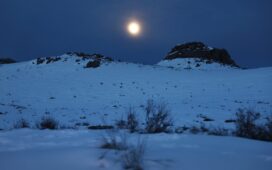Ancient people from Pompeii caused a major refugee crisis when Vesuvius obliterated their city, burying it under several feet of ash.
An estimated 15,000 to 20,000 survivors poured into nearby settlements where they attempted to re-begin their lives, experts say.
Their movements have been tracked through evidence of ancient road, bath and theatre building projects, and inscriptions of family names on tombs and ancient documents.

Refugees who fled Pompeii moved to nearby Cumae, Naples and Puteoli. Others re-settled in Ostia, near Rome, according to a study by Dr Steven Tuck from Miami University which will be published this year in the journal Analecta Romana

An estimated 15,000 to 20,000 people made it out of pompeii, but an estimated 1,500 to 2,000 people died during the eruption. The outline of their bodies can still be uncovered today
Dr Steven Tuck, from Miami University, has tried to build an image of their movements in his landmark paper to be published this spring in the journal Analecta Romana.
‘Tracing family names from Pompeii and Herculaneum in the populations of other cities after AD 80 (post-eruption) is how I found most of the survivors’, he told MailOnline.
He found that many stayed in the area, settling at nearby Cumae, Naples, and Puteoli, while others moved to Ostia on the outskirts of Rome.
‘The decision of where to resettle is probably personal,’ said Dr Tuck, indicating that there’s no sign of a refugee programme from the Roman government.
‘It is most likely based on personal or economic networks.’
The Sulpicius family, who Dr Tuck identified through their unique name, moved to Cumae after the eruption as they already had property there.
They’re recorded at Pompeii by a strongbox that contained their financial records, and then again in Cumae, on a tomb.
A woman, Vettia Sabina, settled in Naples after she lost her Pompeii home. On her tomb is the word ‘have’, meaning ‘Welcome’ in the Oscan dialect spoken in Pompeii when the Romans took over.
A third person, Cornelius Fuscus, is placed in Romania after the eruption by an inscribed stone, left after he died on a military campaign.

Dr Tuck identified Pompeii refugees through ancient documents, inscriptions and infrastructure projects. This mosaic saying ‘Have’ means welcome and was used in Pompeii. It has also been discovered in Naples on the tomb of Vettia Sabina, suggesting she moved there from Pompeii
‘They said he was from the colony of Pompeii on the inscription’, said Dr Tuck.
‘He lived in Naples and then joined the army.’
There is also evidence that Roman Emperor Titus, who ruled for three years from 79 to 81AD, took money from people who died in the eruption and used it to fund infrastructure projects.
Dr Tuck said Titus, and later Emperor Domitian, claimed credit for the projects which included roads, bridges, baths and amphitheatres.
In Cumae, the road Via Domitiana was added with a monumental arch to link the settlement into Rome’s network, and the temple of Vespasian and Titus was constructed as well as other projects.
In Naples baths and a theatre, or odeon, were also added to accommodate the refugees.

Roman Emperor Titus took money from the dead of Pompeii and re-distributed it among the towns and cities that were building infrastructure to house the refugees. He then claimed credit for the projects

Infrastructure projects included the construction of road Via Domitiana with a monumental arch in Cumae, and baths and a market near the harbour in Puteoli. Pictured: Mount Vesuvius erupting in 1944
Despite this work the study hasn’t found everyone that re-settled, as many slaves and foreigners don’t have stone inscriptions of their names, making them difficult to track.
‘My study actually drastically under counts the number of Romans who got out,’ said Dr Tuck.
When Mount Vesuvius blew its lid it killed between 1,500 and 2,000 people.
Pliny the Younger, who saw the eruption with his uncle Pliny the Elder, wrote that it began in the afternoon.
‘A cloud was ascending, the appearance which I cannot give you a more exact description of than by likening it to that of a pine tree, for it shot up to a great height in the form of a very tall trunk, which spread itself out at the top into a sort of branches.’

However, the study wasn’t able to trace many Pompeii refugees, such as slaves or foreigners, because they didn’t leave any inscriptions with their name on
Later that afternoon he headed out with his uncle in a ship to aid those caught up in the eruption.
‘The ashes now began to fall upon us, though in no great quantity.
‘I looked back; a dense dark mist seemed to be following us, spreading itself over the country like a cloud…
‘We had scarcely sat down when night came upon us, not such as we have when the sky is cloudy, or when there is no moon, but that of a room when it is shut up, and all the lights put out.’
Pompeii was buried under several feet of ash, and was only found again almost 1,600 years later.
The remains buried there have helped archaeologists build a much clearer picture of what Roman life was like.

















